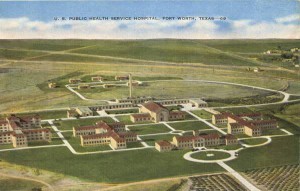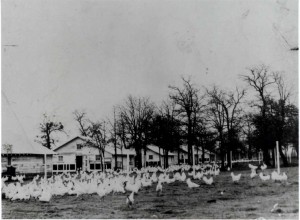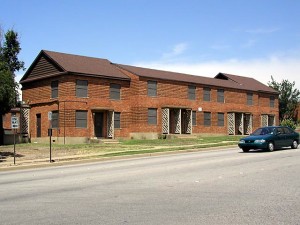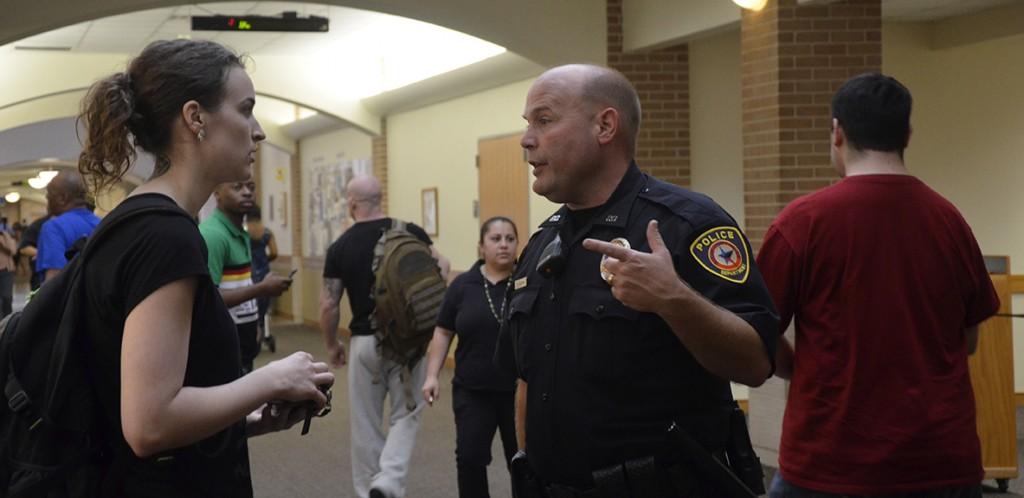South
Nestled between Interstate 20 and Forest Hill, the property now known as South Campus was owned by the federal government in the early 1960s.
The 1,400-acre government property was utilized by the U.S. Public Health Service Hospital, initially opening in 1938 as the Fort Worth Narcotics Hospital. At the time, the hospital was one of two narcotics treatment centers in the U.S. that treated addicted federal prisoners. Soon after opening its doors, the hospital began admitting neuropsychiatric patients as well.

In 1965, the southern portion of the hospital’s land was deemed surplus government property. The General Services Administration, the agency that oversees property acquisition, agreed to donate 158.5 acres of the property to the district to build a campus. In return, the district agreed to a 20-year constraint, which if they followed the restraint, the land would then transfer to the college free and clear.
Shortly after donating the surplus property to what was then Tarrant County Junior College, the narcotics hospital changed responsibilities and became a research clinic in 1967 and later closed in 1971.
Today, the place where the Fort Worth Narcotics Hospital stood is now the Federal Correctional Institution of Fort Worth. It houses minimum-security male inmates, and it provides programs to help train the inmates for re-entry into the workforce through job training.
Northeast
In December 1965, the location of NE Campus was agreed upon, and the land would be purchased from a combination of four families: 150 acres were sold by Robert R. Black, John Murrah and Clyde Tabor and the remaining 38 acres by Mr. and Mrs. Jim B. Mitchell.
Straddling the North Richland Hills and Hurst city limits, NE Campus was not only a wooded plot of land, but it was home to a chicken farmer and possibly horse stables.

Pictures housed in NE’s Heritage Room archives show chicken coops with Leghorn chickens raised on Jesse James Wheat’s farm built in 1928. The farm was just west of today’s campus.
“I’ve been told that there was a riding stable as well,” Tom Kellam, TCC’s archivist, said after sharing the picture of the chicken coops.
While there are few details of the stable or the chicken farm, according to the 1940 census in Wichita Falls, Texas, Clyde Tabor was already involved as a laborer for an egg-laying plant.
Tabor may have purchased Wheat’s farm, but then Tabor may have sold the land later when the campus needed it.
Northwest
The announcement about NW Campus immediately followed that of NE in December 1965.
Don McDowell, reporter for the Fort Worth Star Telegram in 1965, explained the details of the sizable land donation by F. Howard Walsh.
“[The Walsh family] has offered as much land as is needed and stipulated that at least 150 acres will be given the junior college district,” he wrote.
Malcolm Louden, current president for Walsh Ranches, shared the history of the ranch when the property was donated to TCJC.
“The property was used for a working cattle ranch. It was one of Mr. and Mrs. Walsh’s seven ranches,” he said.
In addition to TCJC, the Walsh’s supported various charities and colleges that have a positive impact within the community, including Texas Christian University, Howard Walsh’s alma mater.
The land donated for NW Campus assisted the community in new urban development as well, Louden said.
“The gift of the land for the NW Campus was a major reason that Loop 820 was completed in this area,” he said.
The Walsh Ranch is still a working cattle ranch in Fort Worth, covering 7,275 acres in Parker and Tarrant counties.
The fourth location was built on a wooded site in southeast Tarrant County and opened its doors in 1996. Known today as the SE Campus, the current manicured land and busy streets were simply a vision of the future when contractors broke ground.
Previously, the land was underdeveloped and heavily wooded. Mesquite trees and grazing cattle filled the quiet site before it was sold to TCJC. Today, the campus surroundings include residential neighborhoods, businesses small and large and the hubbub of civilization.
Soon after obtaining SE Campus, the TCJC board members decided to drop “junior” from the college’s name, and it officially became Tarrant County College in 1999.
The fifth and final site to join the TCC family was TR Campus, which was the headquarters of RadioShack until the college bought it for $238 million in 2008.
Before it was a college or a corporate office, the corner of Henderson and Belknap was recognized as one of Fort Worth’s first public housing developments, Ripley Arnold Place. Another development, Butler Place, was built at the same time as Ripley, just a few blocks east.
Edith J. Barrett, former professor of urban and public affairs at the University of Texas at Arlington, explained the difference between the two developments.

“Both were built in the 1930s, Butler to house African-Americans and Ripley to house whites,” Barrett said.
It wasn’t until the 1960s that the properties were racially integrated.
In 2002 when it was decided that Ripley Arnold Place would be demolished and its residents would be relocated to other apartment communities within Fort Worth, Barrett and her students studied the effects on relocation for the residents over the next five years.
“Success of the relocation varied from household to household,” Barrett said. “Some did well, others not so well. Some were evicted who might also have been evicted from Ripley Arnold. Others who were evicted might have been able to stay had they still been at Ripley.”
Today, the corner where the 268-unit complex once sat, the property blends in with the other downtown buildings with gleaming floor-to-ceiling windows, large parking garages and the hustle and bustle of corporate America.





























